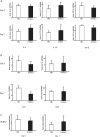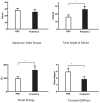Probiotics: Can it modulate fracture healing?
- PMID: 37651346
- PMCID: PMC10470963
- DOI: 10.1371/journal.pone.0290738
Probiotics: Can it modulate fracture healing?
Abstract
Objective: Fractures remain a huge burden and their management adversely affects individuals' function and productivity during the lengthy healing period. Gut microbiota exerts a systemic influence on diverse aspects of host physiology, including bone. The primary objective of this study was to evaluate if oral probiotic treatment before or after a fracture in a mouse model could increase cytokines and biomarkers essential for bone healing with subsequent improvement in the biomechanical properties of the healed callus.
Methods: Femoral osteotomy and intramedullary pinning were performed on C57BL/6 mice. Group 1 received either control PBS or probiotic via oral gavage for 5 weeks before fracture (pre-fracture). Group 2 received equivalent treatments for 4 weeks only after fracture (post-fracture). Fracture calluses were harvested on day 3 and 7 for RT-qPCR to quantify osteogenic-related inflammatory cytokines and bone biomarkers. Fractured femurs were evaluated day 28 post-osteotomy via microstructural analysis (μCT) and biomechanical testing (torsion).
Results: Mice treated with probiotics pre-fracture (group 1) showed significantly increased gene expression on day 3 of cytokines TGF-β, IL-6 and IL-17F and a corresponding increase in gene expression on day 7 for Col1 and Runx2. Significant improvement was also seen in bone volume fraction, bone mineral density, tissue mineral density, maximum yield torque, stiffness and strain energy. Mice treated with probiotics post-fracture (group 2), demonstrated no changes in cytokine or bone marker gene expression with no significant changes on microstructural analysis. However, significant increases were seen in twist angle at failure and strain energy, with a corresponding reduction in torsional stiffness.
Conclusion: Our results suggest that oral probiotic administration, before or after a fracture, may sufficiently alter the gut flora microenvironment leading to improved bone healing biomechanical properties. The use of probiotics may provide a cost-effective and low-risk adjunctive therapy to improve fracture healing.
Copyright: © 2023 Wang et al. This is an open access article distributed under the terms of the Creative Commons Attribution License, which permits unrestricted use, distribution, and reproduction in any medium, provided the original author and source are credited.
Conflict of interest statement
The authors have declared that no competing interests exist.
Figures







Similar articles
-
Micro-computed tomography assessment of the progression of fracture healing in mice.Bone. 2012 Jun;50(6):1357-67. doi: 10.1016/j.bone.2012.03.008. Epub 2012 Mar 17. Bone. 2012. PMID: 22453081
-
Ovariectomy-Induced Osteopenia Influences the Middle and Late Periods of Bone Healing in a Mouse Femoral Osteotomy Model.Rejuvenation Res. 2015 Aug;18(4):356-65. doi: 10.1089/rej.2015.1682. Rejuvenation Res. 2015. PMID: 25694054
-
Exposure to Secondhand Smoke Impairs Fracture Healing in Rats.Clin Orthop Relat Res. 2017 Mar;475(3):894-902. doi: 10.1007/s11999-016-5184-6. Epub 2016 Nov 30. Clin Orthop Relat Res. 2017. PMID: 27905059 Free PMC article.
-
Time-dependent effects of sclerostin antibody on a mouse fracture healing model.J Musculoskelet Neuronal Interact. 2013 Jun;13(2):178-84. J Musculoskelet Neuronal Interact. 2013. PMID: 23728104
-
Erythropoietin does not improve fracture healing in aged mice.Exp Gerontol. 2019 Jul 15;122:1-9. doi: 10.1016/j.exger.2019.04.005. Epub 2019 Apr 16. Exp Gerontol. 2019. PMID: 30998964
Cited by
-
Investigation of the relationship between apical periodontitis and host modulation provided by nutritional supplement: a study in rats.BMC Oral Health. 2025 Mar 4;25(1):336. doi: 10.1186/s12903-025-05705-z. BMC Oral Health. 2025. PMID: 40038698 Free PMC article.
-
Enhanced osteogenic differentiation in 3D hydrogel scaffold via macrophage mitochondrial transfer.J Nanobiotechnology. 2024 Sep 5;22(1):540. doi: 10.1186/s12951-024-02757-1. J Nanobiotechnology. 2024. PMID: 39237942 Free PMC article.
References
-
- Wang Y, Kim J, Whyne C, Nam D. A two-phase regulation of bone regeneration: IL-17F mediates osteoblastogenesis via C/EPB-β in vitro. Bone. 2018. Nov Vol 116: 47–57. - PubMed
Publication types
MeSH terms
Substances
LinkOut - more resources
Full Text Sources
Medical

